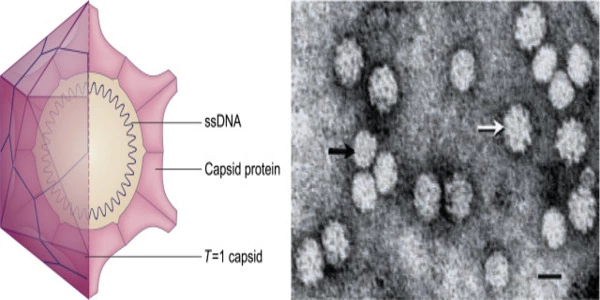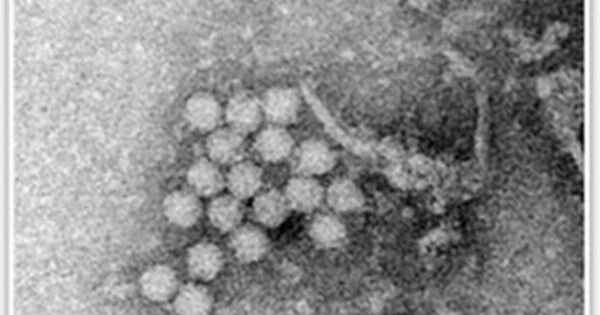Circoviruses are a family of small, circular, single-stranded DNA viruses that are known to cause diseases in a variety of animals, including birds and pigs. Some circoviruses have been detected in humans, but they are not known to cause any disease in humans.
Hepatitis, on the other hand, is a disease characterized by inflammation of the liver. There are several types of hepatitis, including hepatitis A, B, C, D, and E, which are caused by different viruses. Hepatitis B and C viruses are known to cause chronic hepatitis, which can lead to liver cirrhosis and liver cancer.
Scientists have discovered a previously unknown species of circovirus known as human circovirus 1. (HCirV-1). Circoviruses are a group of small, highly resistant DNA viruses discovered in 1974 in a variety of animal species, where they can cause respiratory, renal, dermatological, and reproductive problems. HCirV-1 is a novel virus that is not related to any known animal circoviruses. It was discovered to be involved in liver damage in a patient receiving immunosuppressive treatment.
Scientists from the Institut Pasteur, Necker-Enfants Malades Hospital (AP-HP), Inserm in the Imagine Institute, Université Paris Cité, and the Alfort National Veterinary School (EnvA) have identified a previously unknown species of circovirus, provisionally named human circovirus 1 (HCirV-1).
Circoviruses are a group of small, highly resistant DNA viruses discovered in 1974 in a variety of animal species, where they can cause respiratory, renal, dermatological, and reproductive problems. HCirV-1 is a novel virus that is not related to any known animal circoviruses. It was discovered to be involved in liver damage in a patient receiving immunosuppressive treatment. On January 3, 2023, the journal Emerging Infectious Diseases published the discovery of the first circovirus in humans, which was linked to hepatitis.
With few symptoms, the patient had unexplained chronic hepatitis. She had a heart-lung transplant 17 years before and had been closely monitored ever since. We had access to a large number of samples over a number of years, allowing us to identify this novel virus, which was completely unexpected.
Marc Eloit
Although the transmission of animal viruses to humans is frequently reported in the scientific literature, it is uncommon to find a novel virus in a patient in Europe. However, as part of a recent study, scientists and physicians discovered the first circovirus implicated in human hepatitis.
“With few symptoms, the patient had unexplained chronic hepatitis. She had a heart-lung transplant 17 years before and had been closely monitored ever since. We had access to a large number of samples over a number of years, allowing us to identify this novel virus, which was completely unexpected “explains Marc Eloit, the study’s final author and Head of Institut Pasteur’s Pathogen Discovery laboratory as well as Professor of Virology at the Alfort National Veterinary School (EnvA).
In March 2022, in collaboration with the Department of Clinical Microbiology at Necker-Enfants Malades Hospital (AP-HP), the pathological tissue samples of this 61-year-old female patient receiving immunosuppressive treatment, whose hepatitis had no identifiable cause, were sequenced to search for microbial sequences. The RNA (ribonucleic acid) sequences extracted from the tissues were analyzed and compared with those of known microbes.
“The goal is to find sequences of interest among all the sequences obtained, which is like looking for a needle in a haystack!” continues the scientist Marc Eloit. Thousands of RNA sequences were analyzed in parallel using mNGS (metagenomic next-generation sequencing) high-throughput sequencing techniques and sophisticated algorithms. After ruling out common etiologies, the researchers identified a previously unknown species of circovirus, tentatively named human circovirus 1. (HCirV-1). There was no other viral or bacterial sequence discovered.

The role of HCirV-1 in hepatitis was then demonstrated by analyzing samples collected from the patient during her post-transplant treatment in previous years. According to the findings, the HCirV-1 viral genome was undetectable in blood samples from 2017 to 2019, then peaked in September 2021. Viral replication was demonstrated in liver cells (2 to 3% of liver cells were infected), pointing to the role of HCirV-1 in liver damage: once the virus has used the resources in the liver cell to replicate, it destroys the cell.
Following antiviral treatment, the patient’s liver enzymes returned to normal levels in November 2021, indicating the end of hepatic cytolysis.
Diagnosis of unknown etiology hepatitis remains a major challenge, as evidenced by cases of acute hepatitis reported in children in the United Kingdom and Ireland last April and signaled by WHO. “To offer appropriate treatment and effectively monitor patients, we need to know the cause of hepatitis, particularly whether it is viral. The discovery of this novel pathogenic virus in humans, as well as the development of a test that can be performed in any hospital laboratory, provides a new tool for diagnosing and monitoring patients with hepatitis “Anne Jamet, of the Department of Clinical Microbiology at Necker-Enfants Malades Hospital (AP-HP) and co-last author of the study, emphasizes.
Although some circoviruses are pathogenic to animals and vaccines can be given, particularly to pigs, this is the first known circovirus that is pathogenic to humans. The patient’s symptoms remained mild, and the virus was identified because she was closely monitored after her combined transplant. The virus’s origin, whether it is circulating in humans or in animals, has yet to be determined, as has the source of infection (contact, food, etc.). Following their discovery, the scientists created a specific PCR test that is now available for the etiological diagnosis of unknown hepatitis. A serological test is also in the works.
“These findings demonstrate the utility of this type of sequencing analysis in detecting novel or unexpected pathogens. Clinicians must always know whether or not an infection is viral in order to tailor treatment accordingly. It is also critical to be able to identify a novel pathogen when an infection goes undiagnosed and to develop a diagnostic test, because any new case of human infection with an emerging pathogen could signal the start of an outbreak “Marc Eloit comes to a close. The test is now available to the medical community and can be used to diagnose other cases of unexplained hepatitis.
















